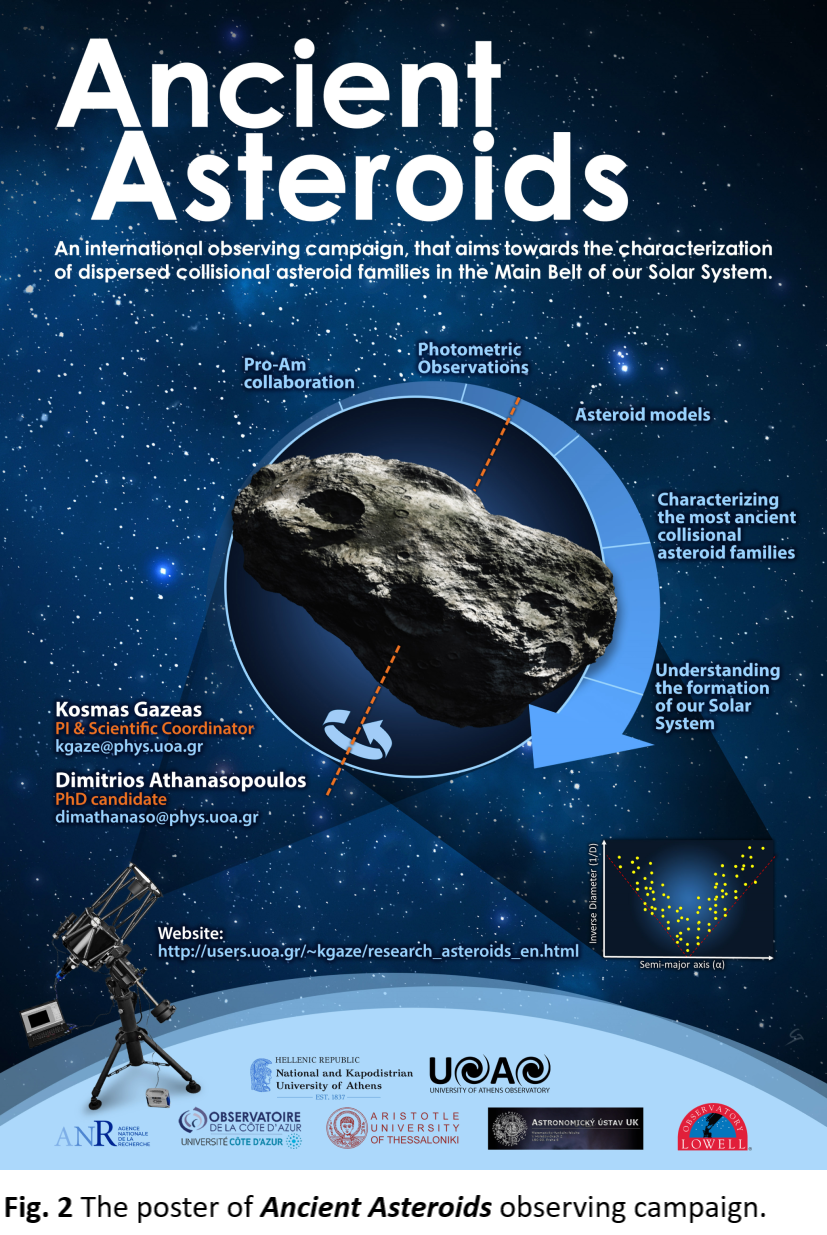Ancient Asteroids: An international observing campaign for the characterisation of the oldest asteroid collisional families
- 1Section of Astrophysics, Astronomy and Mechanics, Department of Physics, National and Kapodistrian University of Athens, Zografos GR 15784, Athens, Greece (dimathanaso@phys.uoa.gr)
- 2BSA Osservatorio (K76), Strada Collarelle 53, 12038 Savigliano, Cuneo, Italy
- 3Lowell Observatory, 1400 West Mars Hill Road, Flagstaff, AZ 86001, USA
- 4Université Côte d’Azur, CNRS–Lagrange, Observatoire de la Côte d’Azur, CS 34229 – F 06304 NICE Cedex 4, France
- 5Bigmuskie Observatory (B88), via Italo Aresca 12, 14047 Moberelli, Asti, Italy
- 6Charles University in Prague, Astronomical Institute, Faculty of Mathematics and Physics, Prague, V Holešovičkách 2, CZ 18000 Prague 8, Czech Republic
- 7Section of Astrophysics Astronomy & Mechanics, Department of Physics, Aristotle University of Thessaloniki, GR 541 24 Thessaloniki, Greece
Introduction
We invite observers to join an international observing campaign and obtain light curve of a selected number of the most ancient asteroids. Analysis of these data will be important to reconstruct the original state of the asteroid belt, which is a crucial problem of planetary science. This original state can be reconstructed through the identification of the oldest asteroid families. Traditional identification methods, like Hierarchical Clustering Methods (Zappala et al., 1990; HCM), have difficulties to recognise Gyr- and older asteroid families, whose members are very dispersed by the Yarkovsky effect. An innovative method, called V-shape search (Bolin et al., 2017), has been demonstrated effective (Deienno et al. 2021) to identify these aforementioned very old collisional families by searching for the signature of the size dependent dispersion of family members operated by the Yarkovsky effect.
The method has already successfully identified two primordial families which likely formed before the giant planet orbital instability (Tsiganis et al., 2005) and could be as old as the Solar System and an ancient one that is ~3 Gyr-old (Delbo et al., 2017; 2019). There is evidence from observations and theoretical evolution models that there are more old families to be detected (Delbo et al., 2017; Dermott et al., 2018). However, the reliability of these V-shape families should be independently verified.
A very important test of family membership is the anisotropic distribution of spin vectors of the asteroid family member, which is a fingerprint of the Yarkovsky effect evolution (Hanus et al. 2013). Namely, to test the working hypothesis that according to theories of asteroid orbital evolution under the Yarkovsky effect, members of the inward (outward) side of V-shape of a family have a statistical predominance of retrograde (prograde) objects (Fig. 1). This hypothesis has been tested (Hanus, et al., 2013) already for known families, and it is a reliable test for family membership.
The observing campaign: Ancient Asteroids
For this purpose, an international observing campaign called Ancient Asteroids has been put forward at different observatories worldwide: (University of Athens Observatory (UOAO), Greece, the BSA Observatory and Bigmuskie Observatory, Italy, the Observatoire de la Côte d’Azur (OCA), France, the Lowell Observatory in Arizona, United States, the Astronomical Institute of the Charles University in Prague, Czech Republic, the Aristotle University of Thessaloniki in Thessaloniki, Greece. The main goal of the campaign is to establish an international network of professional and amateur astronomers (Pro-Am collaboration), in order to perform photometric observations of a very specific sample of the most ancient asteroids. A special website (http://users.uoa.gr/~kgaze/research_asteroids_en.html) was developed for the purpose of the campaign, that includes guidelines for the participation, the observations and the image data evaluation and collection.
In the frame of Ancient Asteroids campaign, a user-friendly web application was also developed for the target selection and observing plan preparation. The user can easily find the observable asteroids for the campaign based on the location, the time and the equipment limitations. The targets are displayed with a priority rate, in order to perform smart sampling. The user selects the favor target and an observing plan automatically is created.
The contribution
The obtained lightcurves from all the involved participants will be combined with data available in the literature, as well as with sparse data from space missions (Gaia, TESS, etc) and global sky surveys (PTF, LSST, ATLAS, etc). Thus, the spin state of the asteroids can be revealed. The results will be ingested to the Minor Planet Physical Properties Catalogue (MP3C) program (https://mp3c.oca.eu/catalogue/index.htm), the largest database of asteroid physical properties, which complies with the EU vision for open data.
The observing campaign Ancient Asteroids has started to collect photometric observations with the contribution of amateur astronomers from Italy, France and Greece are submitted. The observations will reveal the spin state of the members, which are crucial for the testing the hypothesis of the family membership. This research will potentially lead to a better understanding of the first stages of the evolution of the Solar System, the mechanism at the origin of the formation of the asteroids and the planet formation processes.

Acknowledgments
This work was also partially supported by the ANR ORIGINS (ANR-18-CE31-0014) and by the French National Program of Planetology (PNP). Here we make use of asteroid physical properties data from Minor Planet Physical Properties Catalog (https://mp3c.oca.eu/).
References
Bolin, B. T. et al. (2017). Icarus, 282, 290-312.
Deienno, R. et al. (2021). Icarus, 357, 114218.
Delbo, M. et al. (2019). Astronomy & Astrophysics, 624, A69.
Delbo, M. et al. (2017). Science, 357, 6355.
Dermott, S. F. et al. (2018). Nature Astronomy, 2, 7.
Hanus, J. et al. (2013). Astronomy & Astrophysics, 559.
Hanus, J. et al. (2013). Astronomy & Astrophysics, 551.
Tsiganis K. et al. (2005). Nature, 435, 7041.
Zappala, V. et al. (1990). Astrophysical Journal, 100, 2030-2046.
How to cite: Athanasopoulos, D., Bonamico, R., Van Belle, G., Conjat, M., Ferrero, A., Hanuš, J., Ďurech, J., Avdellidiou, C., Tsiganis, K., Delbo, M., and Gazeas, K.: Ancient Asteroids: An international observing campaign for the characterisation of the oldest asteroid collisional families, Europlanet Science Congress 2021, online, 13–24 Sep 2021, EPSC2021-355, https://doi.org/10.5194/epsc2021-355, 2021.

